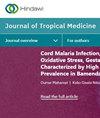Prevalence and Associated Factors of Dengue Virus Circulation in the Rural Community, Handeni District in Tanga, Tanzania
IF 2.5
4区 医学
Q3 PUBLIC, ENVIRONMENTAL & OCCUPATIONAL HEALTH
引用次数: 0
Abstract
Dengue virus is among the most important re-emerging arbovirus that causes global public health attention. Dengue has historically been thought of as an urban disease that frequently occurs in rapidly urbanized settings. However, dengue has become more widespread in rural regions in recent years. Understanding the changing dengue epidemiology in different geographical settings is important for targeted intervention. In Tanzania, dengue fever is not frequently reported because of the poor surveillance infrastructure, underestimation, and a lack of consideration of dengue as a priority. Therefore, the true burden as well as the risk factors for increased transmission has not been fully ascertained, particularly in rural areas. A cross-sectional community-based study was conducted in June 2021, involving a total of 362 participants of all age groups. We investigated the prevalence of acute dengue infection, seroprevalence, and associated factors among the community in three villages of the rural Handeni district. The prevalence of acute dengue infection (based on PCR) was 2.2% (8/362). Dengue-specific IgM and IgG antibodies were detected in 3.3% (12/362) and 5.2% (19/362) of the participants, respectively. Adult participants who were having vegetation around their houses were more likely to be DENV seropositive (AOR = 2.4, CI = 1.88–4.18, value = 0.05). Children living in houses with garbage pit around their households were less likely to be DENV seropositive (AOR = 0.13, CI = 0.03–0.56, value <0.01). DENV continues to circulate in rural Tanzania, causes an alarming situation, and necessitates prompt public health action to enhance vector surveillance and control in rural communities.坦桑尼亚坦噶汉德尼县农村社区登革热病毒流行及相关因素
登革热病毒是引起全球公共卫生关注的最重要的再发虫媒病毒之一。登革热历来被认为是一种城市疾病,经常发生在快速城市化的环境中。然而,近年来登革热在农村地区变得更为普遍。了解不同地理环境中登革热流行病学的变化对有针对性的干预措施很重要。在坦桑尼亚,由于监测基础设施薄弱、对登革热的估计不足以及未将登革热作为优先事项加以考虑,登革热不常被报告。因此,真正的负担以及增加传播的风险因素尚未完全确定,特别是在农村地区。2021年6月进行了一项以社区为基础的横断面研究,涉及所有年龄组的362名参与者。我们调查了Handeni农村地区三个村庄社区急性登革热感染的流行情况、血清阳性率和相关因素。急性登革热感染率(基于PCR)为2.2%(8/362)。登革热特异性IgM和IgG抗体检出率分别为3.3%(12/362)和5.2%(19/362)。房屋周围有植被的成年参与者更有可能出现DENV血清阳性(AOR = 2.4, CI = 1.88-4.18, p值= 0.05)。生活在家庭周围有垃圾坑的家庭的儿童DENV血清阳性的可能性较低(AOR = 0.13, CI = 0.03 ~ 0.56, p值<0.01)。DENV继续在坦桑尼亚农村传播,造成令人震惊的情况,需要迅速采取公共卫生行动,加强农村社区的病媒监测和控制。
本文章由计算机程序翻译,如有差异,请以英文原文为准。
求助全文
约1分钟内获得全文
求助全文
来源期刊

Journal of Tropical Medicine
Immunology and Microbiology-Parasitology
CiteScore
3.90
自引率
4.50%
发文量
0
审稿时长
14 weeks
期刊介绍:
Journal of Tropical Medicine is a peer-reviewed, Open Access journal that publishes original research articles, review articles, and clinical studies on all aspects of tropical diseases. Articles on the pathology, diagnosis, and treatment of tropical diseases, parasites and their hosts, epidemiology, and public health issues will be considered. Journal of Tropical Medicine aims to facilitate the communication of advances addressing global health and mortality relating to tropical diseases.
 求助内容:
求助内容: 应助结果提醒方式:
应助结果提醒方式:


